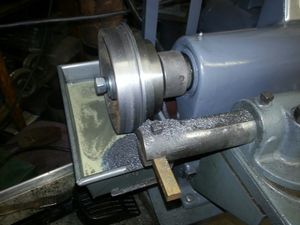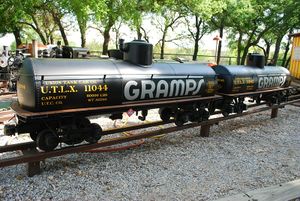Turning wheels: Difference between revisions
No edit summary |
No edit summary |
||
| Line 1: | Line 1: | ||
[[Category:Construction]] | [[Category:Construction]] | ||
== Tom Bee == | |||
Shows the usage of Tom Bee's custom designed wheel turning fixture that he built for use on a lathe many years ago. This is a one of a kind! It can be used for any diameter or width, having a 3/16" tall flange. This is only the demonstration, without an explanation. Published on Nov 5, 2012 | Shows the usage of Tom Bee's custom designed wheel turning fixture that he built for use on a lathe many years ago. This is a one of a kind! It can be used for any diameter or width, having a 3/16" tall flange. This is only the demonstration, without an explanation. Published on Nov 5, 2012 | ||
| Line 11: | Line 13: | ||
<videoflash>ZJB2Mo890vw</videoflash> | <videoflash>ZJB2Mo890vw</videoflash> | ||
<br><br> | <br><br> | ||
== Auto Tread Turner == | |||
Bill Laird posted on <i>Narrow Gauge Builders Yahoo Group</i>: | |||
: The last thing finished, in conjunction with fellow builder Terry McCauley, were two 2-1/2 inch scale Gramps tank cars (see photo below). I have several other projects, and one worth mentioning is, again with Terry, an automatic wheel lathe. Started with an old automotive brake drum lathe. Added stepper motors and electronics to follow the [[Wheel Standard|IBLS wheel profile standard]]. Some of us Texas narrow gauge builders got together and made a generic 2-1/2 inch scale freight car wheel pattern and had a local cast iron foundry cast 100 wheel castings. Turning that many wheels is a daunting task. The automatic wheel lathe takes alot of the drudgery out of it. Process is face off the back of the casting on an engine lathe, drill and ream the axle hole, clean up the rim, face off the front of the casting, and turn the casting to final wheel thickness. Then it is put on the automatic wheel lathe for turning the tread profile and flange. The automatic wheel lathe can handle any wheel up to about 12" diameter and 3" thick. To date it has turned well over a hundred wheels. | |||
<gallery widths="300px" heights="300px" rowsper="2"> | |||
File:AutomaticWheelLathe BillLaird.jpg|Automatic Wheel Lathe built by Bill Laird and Terry McCauly. Photo by Bill Laird. | |||
File:AutomaticWheelLathe BillLaird2.jpg | |||
File:BillLaird NarrowGaugeTankers AVWR.jpg|A pair of 2-1/2 inch scale narrow-gauge "Gramps" tank cars built by Bill Laird, shown here at [[Annetta Valley & Western Railroad]]. | |||
</gallery> | |||
Revision as of 23:36, 4 January 2016
Tom Bee
Shows the usage of Tom Bee's custom designed wheel turning fixture that he built for use on a lathe many years ago. This is a one of a kind! It can be used for any diameter or width, having a 3/16" tall flange. This is only the demonstration, without an explanation. Published on Nov 5, 2012
<videoflash>2jIx9UWLkGA</videoflash>
Shows the usage of Tom Bee's custom designed wheel turning fixture that he built for use on a lathe many years ago. This is a one of a kind! IT can be used for any diameter or width, having a 3/16" tall flange. Published on Nov 5, 2012
<videoflash>ZJB2Mo890vw</videoflash>
Auto Tread Turner
Bill Laird posted on Narrow Gauge Builders Yahoo Group:
- The last thing finished, in conjunction with fellow builder Terry McCauley, were two 2-1/2 inch scale Gramps tank cars (see photo below). I have several other projects, and one worth mentioning is, again with Terry, an automatic wheel lathe. Started with an old automotive brake drum lathe. Added stepper motors and electronics to follow the IBLS wheel profile standard. Some of us Texas narrow gauge builders got together and made a generic 2-1/2 inch scale freight car wheel pattern and had a local cast iron foundry cast 100 wheel castings. Turning that many wheels is a daunting task. The automatic wheel lathe takes alot of the drudgery out of it. Process is face off the back of the casting on an engine lathe, drill and ream the axle hole, clean up the rim, face off the front of the casting, and turn the casting to final wheel thickness. Then it is put on the automatic wheel lathe for turning the tread profile and flange. The automatic wheel lathe can handle any wheel up to about 12" diameter and 3" thick. To date it has turned well over a hundred wheels.
A pair of 2-1/2 inch scale narrow-gauge "Gramps" tank cars built by Bill Laird, shown here at Annetta Valley & Western Railroad.


